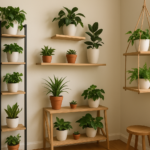Starting seeds can be daunting, but with Rapid Rooter plugs, the process becomes much simpler and more effective. Rapid Rooter plugs are made from organic materials designed to provide an ideal environment for seed germination and root development. Their spongy texture retains the right amount of moisture while allowing for excellent aeration, ensuring your seeds have the best start possible. Whether you’re a seasoned gardener or a beginner, understanding how to use these plugs properly can make a significant difference in your gardening success.
In this guide, we’ll walk you through the step-by-step process of using Rapid Rooter plugs, from selecting the right seeds to transplanting healthy seedlings into your garden or hydroponic system. Follow these tips to ensure your plants thrive from the beginning, leading to a bountiful harvest.
What are Rapid Rooter Plugs?

Rapid Rooter plugs are innovative gardening tools that simplify starting seeds and rooting cuttings. Made from a unique blend of composted organic materials, these plugs have a spongy, absorbent texture that provides an optimal environment for seed germination and root development. The structure of Rapid Rooter plugs ensures they retain moisture efficiently while allowing for excellent aeration, which is crucial for healthy root growth. Each plug features a pre-drilled hole, making it easy to insert seeds or cuttings. They are versatile and can be used in various growing systems, including soil, hydroponics, and aeroponics.
Rapid Rooter plugs are also biodegradable, making them an eco-friendly choice for gardeners. Their ease of use and ability to provide a consistent, nurturing environment for plants make them a favourite among amateur and professional growers. Whether starting a small home garden or managing a more extensive growing operation, Rapid Rooter plugs can enhance your success.
If need Rapid Rooter plugs read our Review :General Hydroponics Rapid Rooter Plugs Review 2024
Composition and Structure
Rapid Rooter plugs are crafted from a unique blend of composted organic materials and natural binders, designed to create an optimal environment for seed germination and root growth. The primary component is peat moss, known for its excellent moisture-retention properties. This is combined with other organic materials like composted bark or coconut coir, which contribute to the plug’s structural integrity and nutrient content.

The manufacturing process involves compressing these materials into a sponge-like texture. This texture is crucial because it balances air and water, ensuring the roots receive enough oxygen while staying adequately hydrated. The sponge-like nature also helps prevent overwatering, which can lead to root rot.
Each Rapid Rooter plug features a pre-drilled hole at the top, making it easy to insert seeds or cuttings. The plugs are uniformly shaped, ensuring consistency in size and structure, which helps maintain a stable environment for the young plants.
Additionally, the plugs are biodegradable, meaning they will naturally break down over time, enriching the soil as they decompose. This eco-friendly aspect makes them an excellent choice for gardeners who prioritize sustainability. Overall, the composition and structure of Rapid Rooter plugs are meticulously designed to support robust plant growth from the very start.
Why Use Rapid Rooter Plugs?
Rapid Rooter plugs offer numerous advantages that can significantly enhance your gardening efforts. First and foremost, these plugs provide an ideal balance of moisture and aeration, promoting robust root development and reducing the risk of root rot. This balance is essential for healthy seedling growth, ensuring roots receive enough oxygen while staying adequately hydrated. Rapid Rooter plugs are also incredibly easy to use, with pre-drilled holes that simplify planting seeds or cuttings. Their consistent structure helps maintain a stable environment, reducing the likelihood of transplant shock when moving seedlings to their final growing location.

Additionally, these plugs are biodegradable, aligning with sustainable gardening practices. They are compatible with various growing methods, including soil-based and hydroponic systems, offering versatility for different gardening preferences. Rapid Rooter plugs can help you achieve higher germination rates and healthier plants, ultimately leading to a more productive garden by providing a reliable and efficient medium for starting plants.
Benefits of Using Rapid Rooter Plugs
Rapid Rooter plugs offer several advantages for gardeners and growers, making them a popular choice for starting seeds and rooting cuttings. Here are some key benefits:
- Optimal Moisture Retention: The spongy texture of Rapid Rooter plugs ensures they retain the right amount of moisture, which is crucial for seed germination and root development.
- Excellent Aeration: These plugs provide superior aeration, allowing roots to receive the oxygen they need for healthy growth. This helps prevent issues like root rot and promotes vigorous root systems.
- Easy to Use: Rapid Rooter plugs come with pre-drilled holes, simplifying the process of inserting seeds or cuttings. This makes them accessible to both novice and experienced gardeners.
- Versatility: They can be used in various growing systems, including soil, hydroponics, and aeroponics, providing flexibility for different gardening preferences and needs.
- Biodegradable: Made from organic materials, Rapid Rooter plugs are biodegradable and environmentally friendly, supporting sustainable gardening practices.
- Consistent Structure: These plugs’ uniform structure ensures a stable environment for seedlings, reducing transplant shock and improving the chances of successful growth.
- High Germination Rates: The ideal conditions provided by Rapid Rooter plugs often result in higher germination rates compared to other mediums.
- Reusable: Rapid Rooter plugs can be reused with proper care and cleaning, offering cost-effective benefits over time.
Preparing for Planting
Selecting the Right Seeds
Choosing the right seeds is a crucial first step in the planting process. Opt for fresh and viable seeds, as older seeds may have lower germination rates. Consider the growing conditions you can provide, such as light, temperature, and space, and select seeds that thrive. Additionally, think about your goals and preferences. Are you looking for fast-growing vegetables, colourful flowers, or hardy herbs? Reading seed packets or researching online can provide valuable information about different plants’ specific needs and characteristics.
Preparing the Work Area
Creating a clean and organized workspace is essential for a smooth planting process. Select a well-lit area with a flat surface where you can comfortably work. Lay down a protective covering, like newspaper or a plastic sheet, to catch any soil or water spills. Ensure the space is free from drafts and extreme temperatures, which can affect seed germination. A dedicated workspace helps keep your tools and materials easily accessible and reduces the risk of contamination or loss of seeds.
Gathering Necessary Tools
The right tools will make the planting process more efficient and enjoyable. Here’s a checklist of essential items:
- Rapid Rooter Plugs: These will be your growing medium.
- Seed Tray or Container: To hold the plugs.
- Seeds: Choose according to your gardening goals.
- Spray Bottle: For gentle watering to keep the plugs moist without displacing seeds.
- Humidity Dome: To retain moisture and create a controlled environment for germination
- Labels and Markers: These are used to identify different plant varieties.
- Water: Ensure you have access to water to soak the plugs and maintain moisture.
How to Use Rapid Rooter Plugs

Step-by-Step Guide to Using Rapid Rooter Plugs
- Moisten the Plugs: Begin by soaking the Rapid Rooter plugs in water. Allow them to absorb the water until they are fully saturated. This typically takes a few minutes. Once soaked, gently squeeze out any excess water so they are moist but not dripping.
- Insert Seeds: Place a seed into the pre-drilled hole at the top of each plug. Ensure the seed is seated well but not too deep. For tiny seeds, just lightly press them into the surface of the plug.
- Arrange in Tray: Place the seeded plugs into a seed tray or container. Space them out evenly to ensure good air circulation and avoid overcrowding.
- Cover with a Humidity Dome: Cover the tray with a humidity dome to maintain high humidity levels. This creates a mini greenhouse effect, keeping the environment around the seeds moist and warm.
- Monitor and Maintain: Place the tray in a warm area with indirect light. Keep an eye on the moisture levels of the plugs, ensuring they stay consistently moist. Use a spray bottle to mist them if they begin to dry out.
- Provide Light: Once the seeds sprout, remove the humidity dome and place the tray under grow lights or in a location with ample natural light. Ensure the seedlings receive about 12-16 hours of sunlight each day.
- Transplant Seedlings: When the seedlings have developed a few sets of true leaves and the roots are well-established, they can be transplanted into larger containers, soil, or a hydroponic system.
Tips for Optimal Use
- Maintain Moisture: Keep the plugs moist but not soggy. Overwatering can lead to mould growth and root rot, while underwatering can cause the plugs to dry out and damage the seedlings.
- Temperature Control: Seeds generally germinate best at temperatures between 70-80°F (21 and 27°C). If necessary, use a heat mat to maintain optimal temperatures.
- Good Air Circulation: To prevent mould and mildew, ensure good air circulation around the plugs. If using a humidity dome, remove it periodically to allow fresh air to circulate.
- Gentle Watering: Use a spray bottle to water the seeds and young seedlings without disturbing them. This also helps distribute moisture evenly.
- Label Your Plants: Label your plants to keep track of different varieties. This is especially important if you are starting multiple types of seeds.
- Avoid Crowding: Give each plug enough space to grow. Overcrowding can lead to competition for light and nutrients, weakening the seedlings.
- Monitor Seedling Growth: Regularly check the seedlings for signs of stress, pests, or disease. Early detection can help you address any issues before they become serious problems.
Planting Seeds in Rapid Rooter Plugs
How to Insert Seeds Properly
Gently place the seed into the pre-drilled hole in the Rapid Rooter plug. Ensure it’s seated well without being too deep.
Depth and Placement of Seeds
Seeds should generally be inserted at a depth of 1/4 to 1/2 inch, depending on their size. Larger seeds go deeper, while smaller seeds can be placed closer to the surface.
Maintaining Moisture Levels
Maintaining the proper moisture level is crucial. Keep the plugs damp but not soaked; check daily and water them as needed.
Germination Process
What to Expect During Germination
During germination, the seeds sprout and start to grow roots. Depending on the seed type, this stage can take anywhere from a few days to a couple of weeks.
Ideal Conditions for Germination
Provide a warm environment (70-80°F) and indirect light. Keep the humidity high, using a dome if necessary, until the seeds sprout.
Common Issues and Solutions
- Seeds not Sprouting: Check for viability, moisture levels, and temperature.
- Mold on Plugs: Reduce humidity and ensure good air circulation.
Transplanting Seedlings
When to Transplant
Transplant seedlings have a few sets of true leaves and roots visible through the plug.
Preparing Seedlings for Transplant
Harden off seedlings by gradually exposing them to outdoor conditions if moving to an outdoor garden.
Transplanting into Soil or Hydroponic Systems
Carefully move the entire plug to your soil or hydroponic setup, ensuring the roots are not damaged.
Maintaining Rapid Rooter Plugs
- Watering Consistency: Ensure the plugs are kept consistently moist but not soggy. Regularly check the moisture levels and mist the plugs if they dry out.
- Temperature Control: Maintain optimal temperatures, typically between 70-80°F (21-27°C), for seed germination and healthy root growth. Use heat mats if necessary.
- Nutrient Management: Once the seedlings are established, provide a balanced nutrient solution appropriate for the plant species. Avoid over-fertilizing, as this can harm the roots.
- Monitoring Plant Health: Regularly inspect the plants for signs of stress, nutrient deficiencies, or pest infestations. Early detection helps prevent issues that can affect plant growth.
- Cleaning and Reusing Plugs: Clean plants from the plugs thoroughly by removing any remaining plant material. Soak them in a mild bleach solution to disinfect them before reusing them.
- Humidity and Light Control: Maintain appropriate humidity levels and ensure the plugs receive adequate light, particularly after germination. Use a humidity dome during early germination and transition to grow lights once the seedlings have sprouted.
- Preventing Overcrowding: Ensure enough space for each seedling in the hydroponic setup. Overcrowding can lead to competition for nutrients and light, impacting plant health and growth.
Advantages of Rapid Rooter Plugs in Hydroponics
- Optimal Root Development: The structure of Rapid Rooter plugs supports robust root growth by maintaining the perfect balance of moisture and aeration. This promotes healthy, vigorous root systems, which are essential for optimal nutrient uptake in hydroponic setups.
- Ease of Use: Rapid Rooter plugs are user-friendly and integrate seamlessly into hydroponic systems, simplifying starting seeds and transitioning seedlings to the growing system. Their uniform shape and size make them easy to place in net pots or growing modules.
- Enhanced Nutrient Absorption: Rapid Rooter plugs’ excellent moisture retention and aeration allow roots to expand quickly and efficiently, enhancing the plant’s ability to absorb nutrients and water from the hydroponic system.
- Biodegradable: Made from organic materials, Rapid Rooter plugs are biodegradable, making them an eco-friendly option for hydroponic gardening. They break down naturally, contributing to the overall health of the system.
- Improved Germination Rates: Rapid Rooter plugs’ optimal moisture levels and aeration create an ideal environment for seed germination, resulting in higher germination rates compared to other starting media.
- Consistent Environment: Rapid Rooter plugs’ uniform structure ensures a consistent and stable environment for seedlings, reducing the risk of transplant shock and promoting healthy plant growth.
- Compatibility: These plugs are versatile and compatible with various hydroponic systems, including deep water culture (DWC), nutrient film technique (NFT), and aeroponics. They can be used effectively in any setup.
Troubleshooting Common Problems
- Overwatering: If you notice mould or root rot, reduce the watering frequency and ensure the plugs are not in standing water.
- Underwatering: If the plugs dry out, the seeds may fail to germinate. Regularly mist the plugs to maintain optimal moisture levels.
- Poor Germination: This can be caused by suboptimal light, temperature, or moisture conditions. Adjust the environment and ensure proper care.
- Leggy Seedlings: Often, due to inadequate light, the seedlings stretch. Ensure they receive ample light to promote sturdy growth.
- Nutrient Deficiency: Yellowing or stunted growth can indicate a lack of nutrients. Provide the appropriate nutrient solution, adjusting based on plant needs.
- Pest Infestation: Inspect plants regularly and use organic pest control methods to prevent insect damage.
- Transplant Shock: This can occur if the seedlings are not appropriately acclimated before moving to their final growing location. Harden off the seedlings gradually to minimize stress.
- Hydroponic System Issues: If roots are not thriving in the hydroponic setup, check nutrient levels, pH, and water temperature to ensure they are within the optimal range.
Frequently Asked Questions (FAQs)
Can Rapid Rooter plugs be reused?
Yes, they can be reused if they are disease-free and cleaned thoroughly.
Do I need to add nutrients to Rapid Rooter plugs?
Initially, no. As seedlings grow, you can start feeding them with diluted nutrient solutions.
How long do Rapid Rooter plugs last?
They are biodegradable and break down over time, typically lasting through a growing cycle.
Can Rapid Rooter plugs be used in soil?
Yes, they work well in both soil and hydroponic systems.
What should I do if my seeds aren’t sprouting?
Check the seeds’ viability, ensure proper moisture levels, and maintain the right temperature.
Conclusion
Rapid Rooter plugs offer a convenient and efficient way to start and grow healthy seedlings. Their versatility and ease of use make them a valuable tool for novice and experienced gardeners. Following the steps outlined in this guide, you can maximize your success and enjoy thriving plants in no time.







